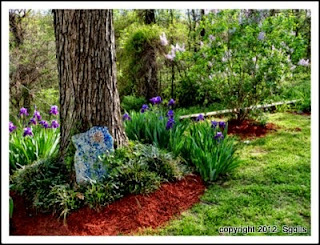Liriope, commonly known as lilyturf or border grass, is a
low growing semi-evergreen perennial ground cover. This ground cover is a
fast-growing and a good choice for erosion control. Liriope grass will
add eye appealing color and movement to your landscape summer through winter.
 |
| Grassy foliage of the liriope border grass |
I grow this plant throughout
my yard as it is a good landscape ground cover. I have planted as a border along my garden paths and around my oak and maple trees. I have
also added it to my hosta garden and as a border to my ornamental grass garden. I like the grass-like foliage that grows
upward from a clump, and the lavender flower that
blooms in late summer make this plant a feature in my garden.
The flower is long-lived, has no fragrance, and when it fades a cluster of blackish berries will appear. These berries are ornamental and will stay on the liriope during winter.
The flower is long-lived, has no fragrance, and when it fades a cluster of blackish berries will appear. These berries are ornamental and will stay on the liriope during winter.
Here are some photographs of liriope gardens and landscape:
Growing Instructions for Liriope Ground Cover
Choosing a Garden Site
Choosing a Garden Site
Plant this ground
cover in a garden that has good drainage you will also need an area that has
part sun to shade. Liriope does not grow well in the intense afternoon sun, as the leaves, will become scorched, but it does grow well in the morning sun,
part shade to shade in the heat of the day and part sun in the evening.
When to Plant
Buy nursery-grown
plants or bare roots. If you intend to do a mass planting then it is wise
to buy bare roots as they cost less and they grow quickly.
Plant in spring after
the danger of frost has past or in fall. Note you can plant liriope
anytime during the growing season provided you water it daily until the roots
establish.
Soak bare-root plants
in tepid water before planting. The water will hydrate the roots and get them
ready for planting. If you plant the bare root in the early spring and
fertilize with spray n' grow then it will bloom the first year.
Plant the liriope in
a hole that is deep enough to accommodate the roots. Cover the roots with soil
that is amended with compost or manure and water well. Space plants 18
inches apart.
Care for your Liriope
Maintain the soil
that is evenly moist but not wet. Apply two inches of mulch around the
liriope to aid in maintaining moisture and to prevent weed growth. Feed with an all-purpose fertilizer in the first week of August. Cut back in March before
new spring growth. Do this by setting your lawnmower blade on high
and mow over the plant.
You can also cut back
with a weed eater, trim the ground cover to 3 inches, this is a safe height as
you do not want to cut too low and damage the crown.
Divide and transplant
in spring as needed Fully-grown plants are fifteen inches in height and width.
Warning
Do not eat the
ornamental berries.
Learn how to divide and transplant liriope border grass by viewing this YouTube.com video:
Learn how to divide and transplant liriope border grass by viewing this YouTube.com video:








